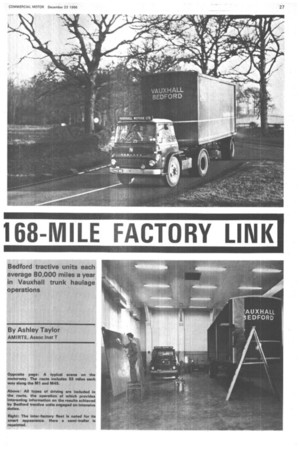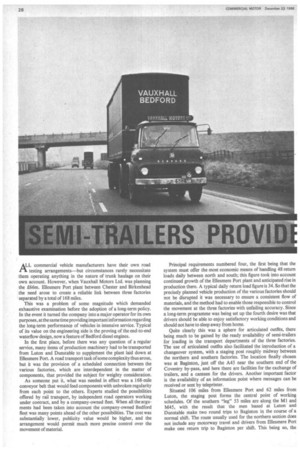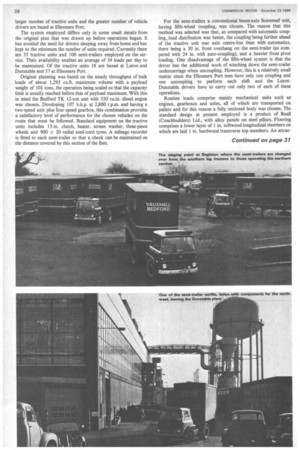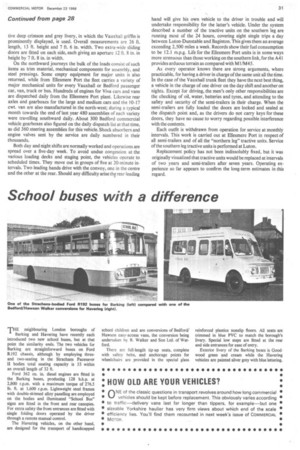168-MILE FACTORY LINK
Page 29

Page 28

Page 30

Page 33

If you've noticed an error in this article please click here to report it so we can fix it.
ALL commercial vehicle manufacturers have their own road testing arrangements—but circumstances rarely necessitate them operating anything in the nature of trunk haulage on their own account. However, when Vauxhall Motors Ltd. was planning the £.66m. Ellesmere Port plant between Chester and Birkenhead the need arose to create a reliable link between three factories separated by a total of 168 miles.
This was a problem of some magnitude which demanded exhaustive examination before the adoption of a long-term policy. In the event it turned the company into a major operator for its own purposes, at the same time providing important information regarding the long-term performance of vehicles in intensive service. Typical of its value on the engineering side is the proving of the end-to-end waterflow design, now a feature of Bedford diesel engines.
In the first place, before there was any question of a regular service, many items of production machinery had to be transported from Luton and Dunstable to supplement the plant laid down at Ellesmere Port. A road transport task of some complexity thus arose, but it was the provision of a scheduled connection between the various factories, which are interdependent in the matter of components, that provided the subject for weighty consideration.
As someone put it, what was needed in effect was a 168-mile conveyor belt that would feed components with unbroken regularity from each point to the others. Experts studied the possibilities offered by rail transport, by independent road operators working under contract, and by a company-owned fleet. When all the arguments had been taken into account the company-owned Bedford fleet was many points ahead of the other possibilities. The cost was substantially lower, publicity value would be higher, and the arrangement would permit much more precise control over the movement of material. Principal requirements numbered four, the first being that the system must offer the most economic means of handling 48 return loads daily between north and south; this figure took into account continued growth of the Ellesmere Port plant and anticipated rise in production there. A typical daily return load figure is 34. So that the precisely planned vehicle production of the various factories should not be disrupted it was necessary to ensure a consistent flow of materials, and the method had to enable those responsible to control the movement at the three factories with unfailing accuracy. Since a long-term programme was being set up the fourth desire was that drivers should be able to enjoy satisfactory working conditions and should not have to sleep away from home.
Quite clearly this was a sphere for articulated outfits, there being much to be gained by the ready availability of semi-trailers for loading in the transport departments of the three factories. The use of articulated outfits also facilitated the introduction of a changeover system, with a staging post roughly midway between the northern and southern factories. The location finally chosen was at Baginton, just off the A45 near the southern end of the Coventry by-pass, and here there are facilities for the exchange of trailers, and a canteen for the drivers. Another important factor is the availability of an information point where messages can be received or sent by teleprinter.
Situated 106 miles from Ellesmere Port and 62 miles from Luton, the staging post forms the central point of working schedules. Of the southern "leg" 53 miles are along the M1 and M45, with the result that the men based at Luton and Dunstable make two round trips to Baginton in the course of a normal shift. The route usually used for the northern section does not include any motorway travel and drivers from Ellesmere Port make one return trip to Baginton per shift. This being so, the larger number of tractive units and the greater number of vehicle drivers are based at Ellesmere Port.
The system employed differs only in some small details from the original plan that was drawn up before operations began. It has avoided the need for drivers sleeping away from home and has kept to the minimum the number of units required. Currently there are 55 tractive units and 100 semi-trailers employed on the service. Their availability enables an average of 34 loads per day to be maintained. Of the tractive units 18 are based at Luton and Dunstable and 37 at Ellesmere Port.
Original planning was based on the steady throughput of bulk loads of about 1,295 cu.ft. maximum volume with a payload weight of 10+ tons, the operation being scaled so that the capacity limit is usually reached before that of payload maximum. With this in mind the Bedford TK 12-ton unit with 330 cuin. diesel engine was chosen. Developing 107 b.h.p. at 2,800 r.p.m. and having a two-speed axle plus four-speed gearbox, this combination provides a satisfactory level of performance for the chosen vehicles on the route that must be followed. Standard equipment on the tractive units includes 13-in, clutch, heater, screen washer, three-piece wheels and 900 X 20 radial steel-cord tyres. A mileage recorder is fitted to each semi-trailer so that a check can be maintained on the distance covered by this section of the fleet. For the semi-trailers a conventional beam-axle Scammell unit, having fifth-wheel coupling, was chosen. The reason that this method was selected was that, as compared with automatic coupling, load distribution was better, the coupling being further ahead of the tractive unit rear axle centre-line than with automatics, there being a 30 in. front overhang on the semi-trailer (as compared with 24 in. with auto-coupling), and a heavier front pivot loading. One disadvantage of the fifth-wheel system is that the driver has the additional work of winching down the semi-trailer undercarriage when uncoupling. However, this is a relatively small matter since the Ellesmere Port men have only one coupling and one uncoupling to perform each shift and the LutonDunstable drivers have to carry out only two of each of these operations.
Routine loads comprise mainly mechanical units such as engines, gearboxes and axles, all of which are transported on pallets and for this reason a fully enclosed body was chosen. The standard design at present employed is a product of Beall (Coa.chbuilders) Ltd., with alloy panels on steel pillars. Flooring comprises, a lower layer of 1 in. softwood longitudinal members on which are laid 1 in. hardwood transverse top members. An attrac tive deep crimson and grey livery, in which the Vauxhall griffin is prominently displayed, is used. Overall measurements are 26 ft. length, 13 ft. height and 7 ft. 6 in. width. Two extra-wide sliding doors are fitted on each side, each giving an aperture 12 ft. 8 in. in height by 7 ft. 8 in. in width.
On the northward journeys the bulk of the loads consist of such items as trim material, mechanical components for assembly, and steel pressings. Some empty equipment for major units is also returned, while from Ellesmere Port the fleet carries a variety of major mechanical units for every Vauxhall or Bedford passenger car, van, truck or bus. Hundreds of engines for Viva cars and vans are dispatched daily from the Ellesmere Port plant. Likewise rear axles and gearboxes for the large and medium cars and the 10-17 cwt. van are also manufactured in the north-west; during a typical month towards the end of last year 480 assemblies of each variety were travelling southward daily. About 300 Bedford commercial vehicle gearboxes also figured on the daily dispatch list at that time, as did 360 steering assemblies for this vehicle. Shock absorbers and engine valves sent by the service are daily numbered in their thousands.
Both day and night shifts are normally worked and operations are spread over a five-day week. To avoid undue congestion at the various loading decks and staging point, the vehicles operate to scheduled times. They move out in groups of five at 20-minute intervals. Two leading hands drive with the convoy, one in the centre and the other at the rear. Should any difficulty arise th5 rear leading
hand will give his own vehicle to the driver in trouble and will undertake responsibility for the latter's vehicle. Under the system described a number of the tractive units on the southern leg are running most of the 24 hours, covering eight single trips a day between Luton-Dunstable and Baginton. This gives them an average exceeding 2,500 miles a week. Records show their fuel consumption to be 12.1 m.p.g. Life for the Ellesmere Port units is in some ways more strenuous than those working on the southern fink, for the A41 provides arduous terrain as compared with M1/1■445.
As every operator knows there are strong arguments, where practicable, for having a driver in charge of the same unit all the time. In the case of the Vauxhall trunk fleet they have the next best thing, a vehicle in the charge of one driver on the day shift and another on nights. Except for driving, the men's only other responsibilities are the checking of oil, water, batteries and tyres, and attending to the safety and security of the semi-trailers in their charge. When the semi-trailers are fully loaded the doors are locked and sealed at the dispatch point and, as the drivers do not carry keys for these doors, they have no cause to worry regarding possible interference with the contents.
Each outfit is withdrawn from operation for service at monthly intervals. This work is carried out at Ellesmere Port in respect of all semi-trailers and of all the "northern leg" tractive units. Service of the southern leg tractive units is performed at Luton.
Replacement policy has not been indissolubly fixed, but it was originally visualized that tractive units would be replaced at intervals of two years and semi-trailers after seven years. Operating experience so far appears to confirm the long-term estimates in this regard.












































































